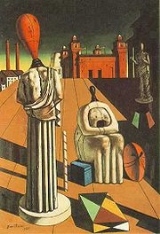
The Disquieting Muses
Encyclopedia
The Disquieting Muses is a painting by the Italian
metaphysical painter
Giorgio de Chirico
.
The Disquieting Muses was painted during World War I
, when De Chirico was in Ferrara
. The Castello Estense
, near which de Chirico lived, is in the background, rust-red and among industrial buildings. At the front are the two Muse
s, dressed in classical
clothing. One is standing and the other sitting, and they are placed among various objects, including a red mask and staff, an allusion
to Melpomene
and Thalia, the Muses of tragedy and comedy. The statue on a pedestal in the background is Apollo
, leader of the Muses.
Giorgio Castelfranco, an art collector and critic, described the painting in 1948:
The artist Carlo Belli discussed the merits of the painting in a letter to the collector Feroldi in 1939:
This painting would later become the inspiration for Sylvia Plath
's poem "The Disquieting Muses".
Italy
Italy , officially the Italian Republic languages]] under the European Charter for Regional or Minority Languages. In each of these, Italy's official name is as follows:;;;;;;;;), is a unitary parliamentary republic in South-Central Europe. To the north it borders France, Switzerland, Austria and...
metaphysical painter
Metaphysical art
Metaphysical art , style of painting that flourished mainly between 1911 and 1920 in the works of the Italian artists Giorgio de Chirico and Carlo Carrà. The movement began with Chirico, whose dreamlike works with sharp contrasts of light and shadow often had a vaguely threatening, mysterious quality...
Giorgio de Chirico
Giorgio de Chirico
Giorgio de Chirico was a pre-Surrealist and then Surrealist Italian painter born in Volos, Greece, to a Genovese mother and a Sicilian father. He founded the scuola metafisica art movement...
.
The Disquieting Muses was painted during World War I
World War I
World War I , which was predominantly called the World War or the Great War from its occurrence until 1939, and the First World War or World War I thereafter, was a major war centred in Europe that began on 28 July 1914 and lasted until 11 November 1918...
, when De Chirico was in Ferrara
Ferrara
Ferrara is a city and comune in Emilia-Romagna, northern Italy, capital city of the Province of Ferrara. It is situated 50 km north-northeast of Bologna, on the Po di Volano, a branch channel of the main stream of the Po River, located 5 km north...
. The Castello Estense
Castello Estense
The Castle Estense or Castle of Saint Michele is a moated medieval structure in the center of Ferrara, northern Italy. It is a large block with four corner towers.- History :...
, near which de Chirico lived, is in the background, rust-red and among industrial buildings. At the front are the two Muse
Muse
The Muses in Greek mythology, poetry, and literature, are the goddesses who inspire the creation of literature and the arts. They were considered the source of the knowledge, related orally for centuries in the ancient culture, that was contained in poetic lyrics and myths...
s, dressed in classical
Classical antiquity
Classical antiquity is a broad term for a long period of cultural history centered on the Mediterranean Sea, comprising the interlocking civilizations of ancient Greece and ancient Rome, collectively known as the Greco-Roman world...
clothing. One is standing and the other sitting, and they are placed among various objects, including a red mask and staff, an allusion
Allusion
An allusion is a figure of speech that makes a reference to, or representation of, people, places, events, literary work, myths, or works of art, either directly or by implication. M. H...
to Melpomene
Melpomene
Melpomene , initially the Muse of Singing, she then became the Muse of Tragedy, for which she is best known now. Her name was derived from the Greek verb melpô or melpomai meaning "to celebrate with dance and song." She is often represented with a tragic mask and wearing the cothurnus, boots...
and Thalia, the Muses of tragedy and comedy. The statue on a pedestal in the background is Apollo
Apollo
Apollo is one of the most important and complex of the Olympian deities in Greek and Roman mythology...
, leader of the Muses.
Giorgio Castelfranco, an art collector and critic, described the painting in 1948:
The artist Carlo Belli discussed the merits of the painting in a letter to the collector Feroldi in 1939:
This painting would later become the inspiration for Sylvia Plath
Sylvia Plath
Sylvia Plath was an American poet, novelist and short story writer. Born in Massachusetts, she studied at Smith College and Newnham College, Cambridge before receiving acclaim as a professional poet and writer...
's poem "The Disquieting Muses".

